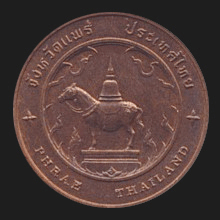|
Phrae (แพร่)
Thai. ‘Propagate, spread’. Province (map) and its capital city of the same name in North Thailand, 551 kms to the North of
Bangkok. It is situated on the southern banks of the
Yom River and has a population of approximately 21,000.
Phrae's history dates back to the
Haripunchai
period of the
Mon, when in 828 AD, the
phaya
Phon (พล) or Pha-la (พละ) led a
group of people from Wiang Phaang Kham (เวียงพางคำ), a city near the legendary
city of
Yonok which predates
Chiang Saen, towards the South. They
settled at the Yom River and founded a town called
Meuang Phon (เมืองพล)
or Pha-la
Nakhon (พละนคร),
named after their leader. In an inscription on the
Stone of Ramkamhaeng,
it is recorded that in 828 the phaya Phon had a first temple built in a place
named Meuang Phlae (เมืองแพล). In the
wihaan, a Buddha image was
installed as the protector of the city and named Saen Luang, a name still
associated with Phrae today. According to records from the
Khmer period,
the city was later referred to as Wiang Kohsai. Also this name is still related
to Phrae today, as it is the name of a local National Park. According to legend, Phrae and
Nan were in the past one kingdom ruled by two brothers, who decided to divide it
between them, to be more easily reigned over. When they met on top of a mountain
that overlooked their kingdom, to discuss the new borders, it is said that the
one from Phrae rode to the meeting point on a horse, the other from Nan came
with a cart pulled by an ox. Hence, Phrae now uses a horse in their provincial
escutcheon, while Nan uses an ox (fig.),
and each city added its own relic to it. Though another legend has it that when
king Pha Kong (ผากอง), a local ruler, wanted to build a
new town, he had a vision. In this dream he saw an ox cross the Nan River and
draw a plan with a square structure in a certain area thus laying the foundation
for the new city. When the king woke up he saw his dream as a vision and he had
the new city walls built accordingly, and the chedi on the back of the ox, used
in the seal of Nan, is here said to contain a relic that the then king received
as a gift from seven monks from
Sukhothai, whom he asked (arahtanah)
to take it to the mountain Phiang Cha Haeng (เพียงแช่แห้ง).
In 1443, Phrae became part of the kingdom
Lan Na, when King Thilokarat (1441-1487)
was on an expedition to seize
Nan. Today, the region is known for the production of
seua mo hom, a blue cotton farmer's shirt seen over much of Thailand and for
Wat Phrathat Cho Hae a famous place of pilgrimage around 10 kms from the city
centre of Phrae.
Besides this, Phrae is the place where the famous love story of
Phra Loh is set. This province has eight
amphur.
See also
Phrae data file, as well as
POSTAGE STAMP and TRAVEL PICTURE.
回






|

